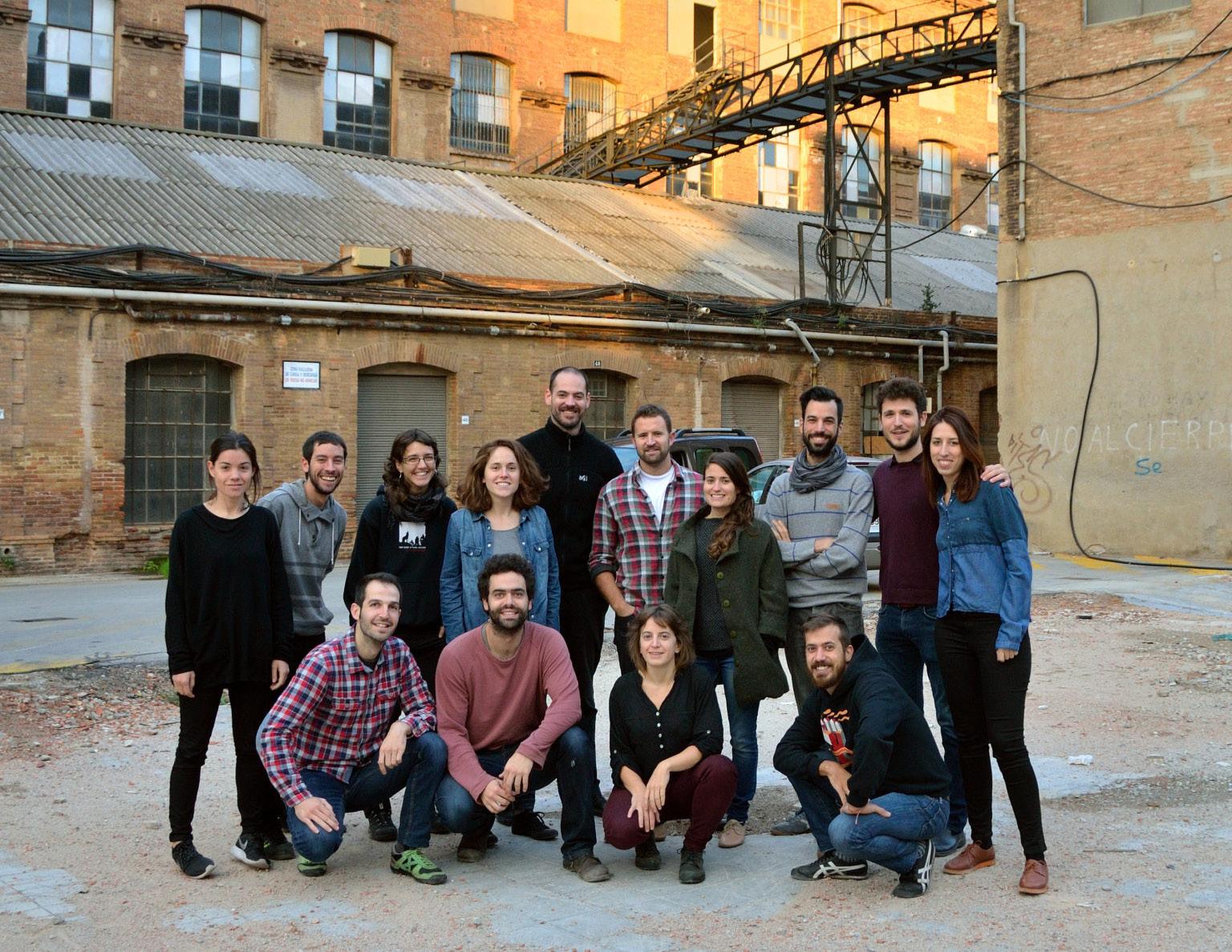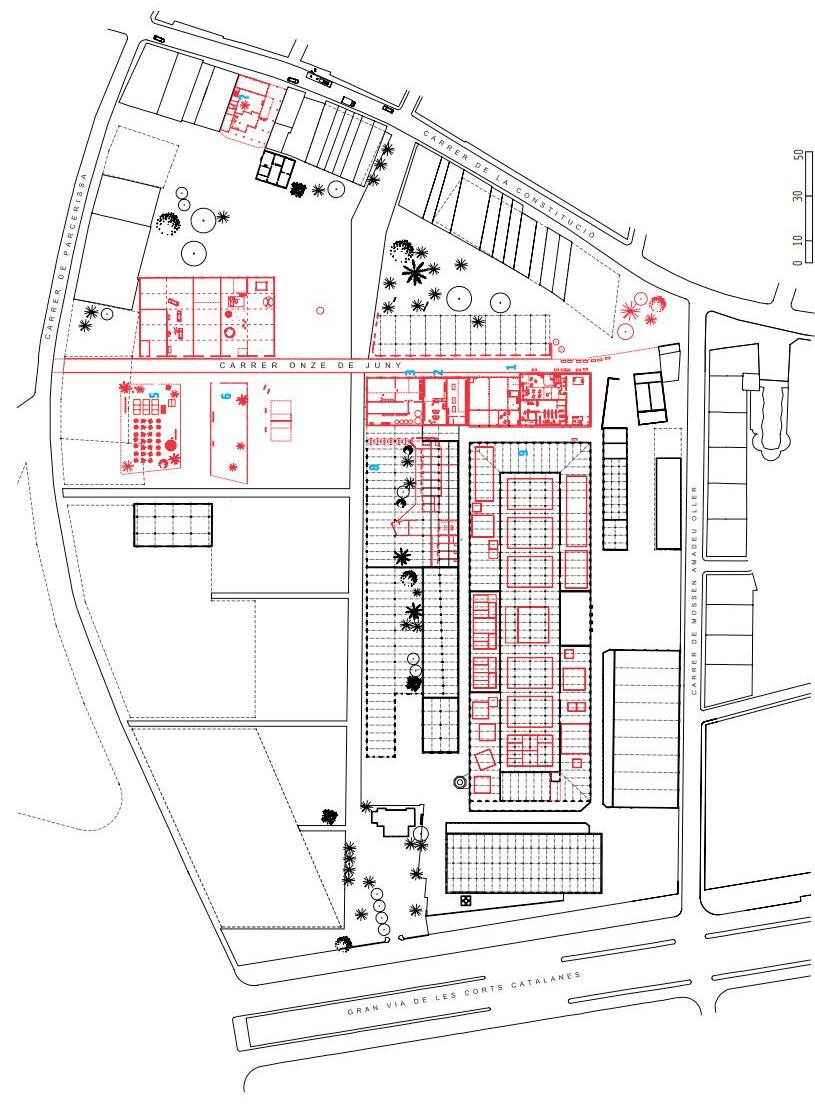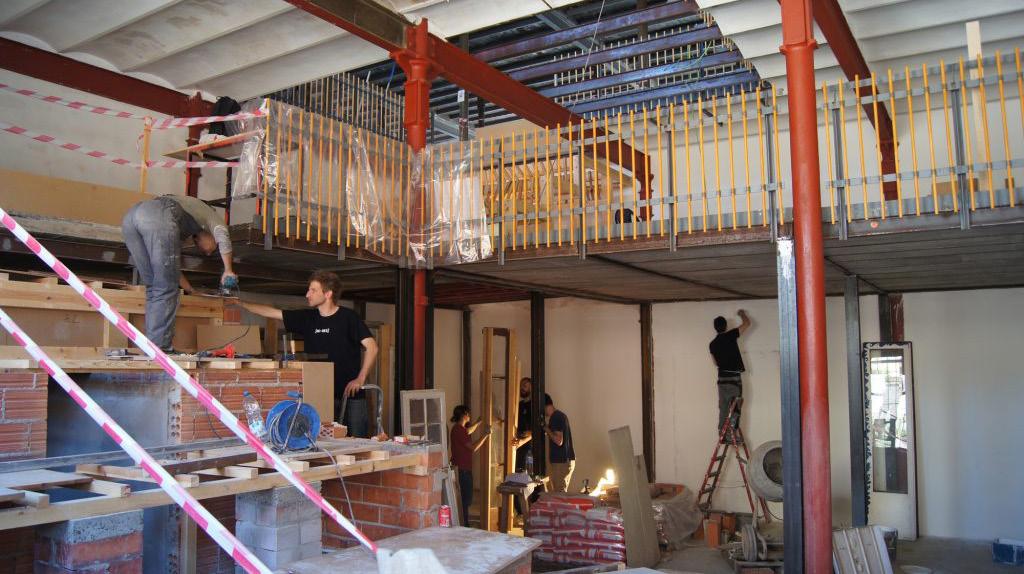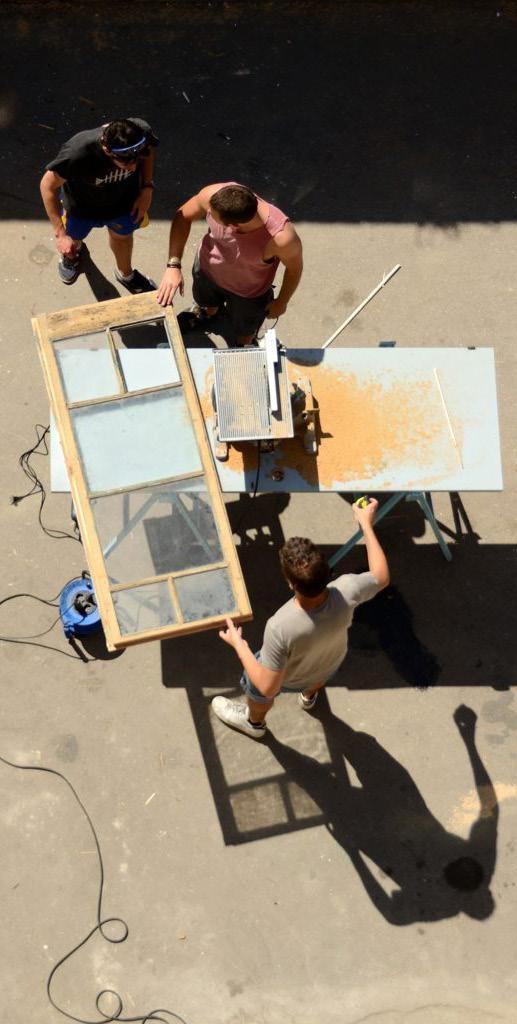
5 minute read
...meetexpertises
The collaboration between Lacol and the grassroots goes back to 2007, as Marc mentions. “They came back then as architecture students motivated and curious enough to discover what was going on at the neighborhood. They quickly formed a relationship of commitment to the neighborhood by participating in several selfmanaged activities run by the people of Can Batlló”. Fascinated and inspired by these practices of commons, after they had finished their master’s in architecture, in 2009 they formed an architectural cooperative –probably inspired by the numerous cooperatives of the district of Sants, an area with long history of cooperatives9. The reason that they formed an architectural cooperative˙ we can probably imagine it as a genuine effort with further intentions to act as team of expertise through horizontal decision-making and by sharing common values, and knowledge in a given space. Since the beginning of their career –even in an intense period of the financial crisis of 2008, especially in the construction sector- they had a common and clear objective. Cristina Gamboa10 in one of their online lecture, they mention throughout the discourse that Lacol works to generate community infrastructures for the sustainability of life, as a key tool for the social transition, through architecture, cooperativism and participation11. Even if there are not the words “commons”, or “commoning” in their position, in my perception source: Wikipedia Contributors (2022) Cooperative. [online] Wikipedia. Available at: https://en.wikipedia.org/wiki/ Cooperative#:~:text=A%20 cooperative%20%28also%20 known%20as%20cooperative%2C%20coop%2C%20or,through%20a%20 jointly%20owned%20and%20 democratically-controlled%20 enterprise%20%22 (Accessed 18 January 2023).
9. “A cooperative (also known as co-operative, co-op, or coop) is «an autonomous association of persons united voluntarily to meet their common economic, social and cultural needs and aspirations through a jointly owned and democraticallycontrolled enterprise”.
Advertisement
10. Cristina Gamboa is one of the main co-founders of the architecture cooperative under the name Lacol.
11. AA School of Architecture (2022) Community Infrastructures – Lacol. 24 January. Available at : https:// www.youtube.com/watch?v=Q I5ebU6LW8k&list=PLI1nDzeoh fnlLq9N7x05VK12u-Sx1KP_w source: Lacol (n.d.) Lacol, image, La Comunal, Available at: https://lacomunal.coop/ projectes/lacol/ (Accessed: 26 January 2023). there are strong evidences of practices of commons in their design practices, and beyond. The aim to create spaces for communities, open to social transitioning by active participation and forces of social economies. Community-oriented practices with the intention to understand the needs and entities of the different commons there.
(Accessed: 19 January 2023).
Just a quick look on their online portfolio, it is enough to come across various of their approaches. Some of them are: temporary activation of empty spaces by participation processes organized as thematic workshops, and by community infrastructures and equipment towards commoning the space and with emphasis on the social and solidarity economy; urban studies including mapping the right to the housing and optimization of empty homes in different cities in Spain; and design and construction of affordable housing projects -especially cooperative housing projects, such as La Borda.
CommunityaskeyinDesign
12. Lacol (2013) Rehabitar Can Batlló. Available at: https:// www.lacol.coop/projectes/ rehabitarcanbatllo/ (Accessed: 18 January 2023).
Back to Can Batlló, year 2011. The second wave of social movements taken part. After the citizens had decided to take the urbanization in their hands, they occupy some buildings of the industrial complex. Since then, it seems that Lacol made a commitment to the community to help them in the transformation12 of some of the areas of the almost abandoned post-industrial site into a complex of community infrastructures that enables commoning to arise, helping services of social economy and solidarity to find shelter for the further development of the space. They gained their trusts through a process of mutual participation in order to be able to help them with their skills and technical knowledge.
After a few years of participation in activism in Can Batlló and general preparation after their master’s diploma they helped in the rehabilitation of the Block 1113 through a community-led process – a building that was taken by the community there as “con cesión de uso” meaning “with assignment of use” from the municipality. In other words, in 2012 community took the responsibility of the development of the building from the state, by owning the use of the land, and not the land itself. It is a kind of lease from the state. A series of commissions then, was held defining the re-activation strategy of the building and the actions to be carried out. The catalyst of the design of the infrastructures was the construction phase including collective, voluntary and self-managed work. Those aspects were the financial and conceptual limits of the final forms of the constructions. The result was: the first place that was turn into a source: Lacol (n.d.) “Site plan”, La Borda / Lacol, drawing, archdaily, Available at: https:// www.archdaily.com/922184/ la-borda-lacol (Accessed: 26 January 2023). sources: common space acting as the meeting place for the social movements of Sants. The success was real. After 2 years of use and expansion of needs of the commoners, Lacol materialized the expansion of space throughout the vertical connection of the block 1114. It was conceived as the central common space of that building, weaving different functions together. Except of the first part of the construction, which was carried out by a company hired by the City Council, the rest of the infrastructure was again community-led practices made by light materials –mostly wood. Block 11 then was turned into a community infrastructure, ready to expand.
13. Lacol (2011) Bloconze de Can Batlló. Available at: https:// www.lacol.coop/projectes/ bloconze-can-batllo/ (Accessed: 18 January 2023).
Master plan proposed by Lacol for the rehabilitation of the abandoned post-industrial site of Can Batlló with spaces that encourage services of social economy and solidarity, with main objective the social sustainability of the broader neighborhood of La Bordeta and the security of its citizens from external neoliberal forces. We can point out the CHP of La Borda and the rehabilitation of the Block 11, ensuring and expanding by doing so the space of commoning in the site.

The photos here show the construction process of the first phase of the rehabilitation of the Block 11 through practices of commons, such as community participation. Having as main ideas the outcome of mutual collaboration with the community and is technical skills as limitation, Lacol designed the infrastructures with materials that found mainly in the site.

The photo on the right top indicates the final result of this collaboration, where the space is both, a result of common practices and an infrastructure that encourages commoning to continue happening.

Photo top right and bottom: Lacol (n.d.) BLOCONZE DE CAN BATLLÓ , image, Lacol, Available at: https://www.lacol.coop/ projectes/bloconze-can-batllo/ (Accessed: 26 January 2023).
Photo top left: Lacol (n.d.) CONNEXIÓ VERTICAL DEL BLOCONZE, image, Lacol, Available at: https://www. lacol.coop/projectes/connexiovertical-bloconze/ (Accessed: 26 January 2023).
14. Lacol (2012) Connexió Vertical del Bloconze. Available at: https://www.lacol.coop/ projectes/connexio-verticalbloconze/ (Accessed: 18 January 2023).
15. Lacol (2014) Estudis Previs Per a Còopolis al Bloc 4. Available at: https://www. lacol.coop/projectes/coopolisespai-leconomia-social-progres/ (Accessed: 18 January 2023).
The success of commoning the Block 11 is perceived by the expansion of occupation towards the Block 415, a neighboring building that the community took over by con cesión de uso in 2014. Like the Block 11, the Block 4 was reactivated by a collaboration method where main criteria to the design was the community-led construction process and the low-budget materials. For that, light structures and reuse of existing materials were beneficial. It is important to understand that the community space here was conceived not as a central space as in the case of Block 1116, but as a scattered series of shared services of social economy ready to be expanded if needed.











